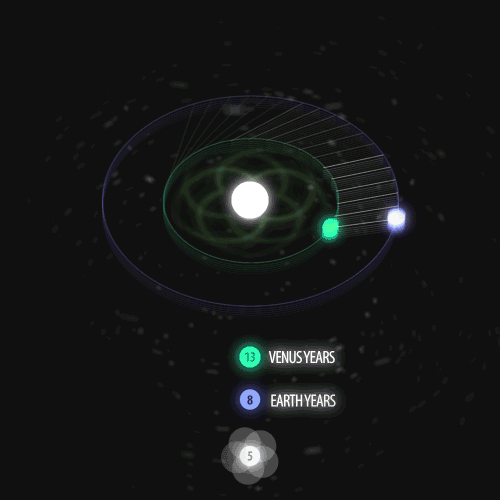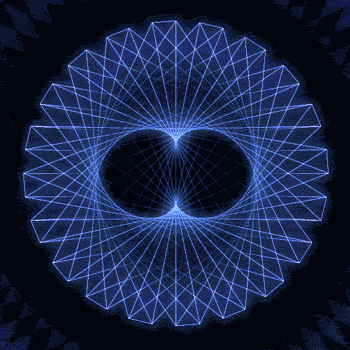Edison’s Cradle?
Edison’s Cradle?

Supplementing the Newton’s Cradle post, Behold the Edison’s cradle ! :)
As part of his senior thesis exhibition at Musashino Art University in Tokyo, art student Yasutoki Kariya re-imagined the ubiquitous desktop gadget, Newton’s Cradle, using a lovely sequence of light bulbs.
Entitled Asobi(which translates roughly as “playing“) the 11-bulb installation creates a visual interpretation of the popular toy named after Sir Isaac Newton demonstrating his third law of motion regarding momentum: that for every action there is an equal and opposite reaction.

The ingenious deception.
However, instead of actual energy created by the kinetic force of steel balls, Kariya devised a method for using programmed light and two surreptitiously placed pistons to create this purely visual experience that’s arguably more mesmerizing than the original concept.
More Posts from Sciencephysics4all-blog and Others

Το Αιγαίο από το διάστημα! Το φαινόμενο sunglint στο Αιγαίο από το διαστημοσυσκευή MODIS της NASA via NASA Earth. Διαβάστε περισσότερα εδώ: https://goo.gl/LqUgJJ

Merry Christmas with geometry!

#sciphy4all #science #physics #english #important#importanter





Fibonacci you crazy bastard….
As seen in the solar system (by no ridiculous coincidence), Earth orbits the Sun 8 times in the same period that Venus orbits the Sun 13 times! Drawing a line between Earth & Venus every week results in a spectacular FIVE side symmetry!!
Lets bring up those Fibonacci numbers again: 1, 1, 2, 3, 5, 8, 13, 21, 34..
So if we imagine planets with Fibonacci orbits, do they create Fibonacci symmetries?!
You bet!! Depicted here is a:
2 sided symmetry (5 orbits x 3 orbits)
3 sided symmetry (8 orbits x 5 orbits)
5 sided symmetry (13 orbits x 8 orbits) - like Earth & Venus
8 sided symmetry (21 orbits x 13 orbits)
I wonder if relationships like this exist somewhere in the universe….
Read the Book | Follow | Hi-Res -2- -3- -5- -8-





Saturn in different wavelengths.
1) Ultraviolet
2) Infrared
3) Infrared
4) X-Ray and Optical
5) Optical

Biochemists at the University of California San Diego have developed artificial cell membranes that grow and remodel themselves in a manner similar to that of living mammalian cells.
The achievement, detailed in a paper published in this week’s issue of the Proceedings of the National Academy of Sciences, follows the successful design last year in the same laboratory of artificial, or synthetic, cell membranes capable of sustaining continual growth. The two developments now bring the researchers closer to mimicking all of the properties of living mammalian cell membranes with synthetic components.
That’s important because synthetic membranes that accurately mimic the behavior of living mammalian cell membranes could be used by biomedical researchers to develop more effective drugs that target membrane proteins and better understand the chemical changes that occur in dysfunctional membranes during disease.
“While artificial membranes have been used to model the properties of native membranes, previous methods have not been able to mimic lipid membrane remodeling,” said Neal Devaraj, an associate professor of chemistry and biochemistry at UC San Diego who headed the research team for both studies. “In our latest study, we show that reversible chemical reactions can be harnessed to achieve spontaneous remodeling of lipids in synthetic membranes.”
Continue Reading.
Juno: Inside the Spacecraft

Our Juno spacecraft was carefully designed to meet the tough challenges in flying a mission to Jupiter: weak sunlight, extreme temperatures and deadly radiation. Lets take a closer look at Juno:
It Rotates!

Roughly the size of an NBA basketball court, Juno is a spinning spacecraft. Cartwheeling through space makes the spacecraft’s pointing extremely stable and easy to control. While in orbit at Jupiter, the spinning spacecraft sweeps the fields of view of its instruments through space once for each rotation. At three rotations per minute, the instruments’ fields of view sweep across Jupiter about 400 times in the two hours it takes to fly from pole to pole.
It Uses the Power of the Sun

Jupiter’s orbit is five times farther from the sun than Earth’s, so the giant planet receives 25 times less sunlight than Earth. Juno will be the first solar-powered spacecraft we’ve designed to operate at such a great distance from the sun. Because of this, the surface area of the solar panels required to generate adequate power is quite large.

Three solar panels extend outward from Juno’s hexagonal body, giving the overall spacecraft a span of about 66 feet. Juno benefits from advances in solar cell design with modern cells that are 50% more efficient and radiation tolerant than silicon cells available for space missions 20 years ago. Luckily, the mission’s power needs are modest, with science instruments requiring full power for only about six out of each 11-day orbit.
It Has a Protective Radiation Vault

Juno will avoid Jupiter’s highest radiation regions by approaching over the north, dropping to an altitude below the planet’s radiation belts, and then exiting over the south. To protect sensitive spacecraft electronics, Juno will carry the first radiation shielded electronics vault, a critical feature for enabling sustained exploration in such a heavy radiation environment.
Juno Science Payload:
Gravity Science and Magnetometers – Will study Jupiter’s deep structure by mapping the planet’s gravity field and magnetic field.

Microwave Radiometer – Will probe Jupiter’s deep atmosphere and measure how much water (and hence oxygen) is there.

JEDI, JADE and Waves – These instruments will work to sample electric fields, plasma waves and particles around Jupiter to determine how the magnetic field is connected to the atmosphere, and especially the auroras (northern and southern lights).
JADE and JEDI

Waves

UVS and JIRAM – Using ultraviolet and infrared cameras, these instruments will take images of the atmosphere and auroras, including chemical fingerprints of the gases present.
UVS

JIRAM

JunoCam – Take spectacular close-up, color images.

Follow our Juno mission on the web, Facebook, Twitter, YouTube and Tumblr.
Make sure to follow us on Tumblr for your regular dose of space: http://nasa.tumblr.com
-
 amaurijuli liked this · 4 years ago
amaurijuli liked this · 4 years ago -
 fillytoria reblogged this · 5 years ago
fillytoria reblogged this · 5 years ago -
 itisntinmyblood-shawnmendes reblogged this · 5 years ago
itisntinmyblood-shawnmendes reblogged this · 5 years ago -
 my-book-love reblogged this · 5 years ago
my-book-love reblogged this · 5 years ago -
 fillytoria reblogged this · 5 years ago
fillytoria reblogged this · 5 years ago -
 fillytoria liked this · 5 years ago
fillytoria liked this · 5 years ago -
 amagiciansmind liked this · 8 years ago
amagiciansmind liked this · 8 years ago -
 funcoolmathgames liked this · 8 years ago
funcoolmathgames liked this · 8 years ago -
 lifeiloveit reblogged this · 8 years ago
lifeiloveit reblogged this · 8 years ago -
 sciencephysics4all-blog reblogged this · 8 years ago
sciencephysics4all-blog reblogged this · 8 years ago -
 chavmed liked this · 8 years ago
chavmed liked this · 8 years ago -
 physicsgifs-blog1 reblogged this · 9 years ago
physicsgifs-blog1 reblogged this · 9 years ago -
 samooooi18 liked this · 9 years ago
samooooi18 liked this · 9 years ago -
 a-physics-student reblogged this · 9 years ago
a-physics-student reblogged this · 9 years ago -
 rr5001 liked this · 9 years ago
rr5001 liked this · 9 years ago -
 chicagobadman69 reblogged this · 9 years ago
chicagobadman69 reblogged this · 9 years ago -
 chicagobadman69 liked this · 9 years ago
chicagobadman69 liked this · 9 years ago -
 punkrock-grapefruit liked this · 9 years ago
punkrock-grapefruit liked this · 9 years ago -
 fragenherrdoktor reblogged this · 9 years ago
fragenherrdoktor reblogged this · 9 years ago -
 tater-tot-goddess liked this · 9 years ago
tater-tot-goddess liked this · 9 years ago -
 apintofstarstuff reblogged this · 9 years ago
apintofstarstuff reblogged this · 9 years ago -
 mariomedhat reblogged this · 9 years ago
mariomedhat reblogged this · 9 years ago -
 mariomedhat liked this · 9 years ago
mariomedhat liked this · 9 years ago -
 theseustheninja liked this · 9 years ago
theseustheninja liked this · 9 years ago -
 iheartshake liked this · 9 years ago
iheartshake liked this · 9 years ago -
 daveo86 liked this · 9 years ago
daveo86 liked this · 9 years ago -
 whenwillieverneedmathematics reblogged this · 9 years ago
whenwillieverneedmathematics reblogged this · 9 years ago -
 omartheox reblogged this · 9 years ago
omartheox reblogged this · 9 years ago -
 sciencey-doggosaurus reblogged this · 9 years ago
sciencey-doggosaurus reblogged this · 9 years ago -
 alecthesavage liked this · 9 years ago
alecthesavage liked this · 9 years ago -
 moralsetmalice reblogged this · 9 years ago
moralsetmalice reblogged this · 9 years ago -
 moralsetmalice liked this · 9 years ago
moralsetmalice liked this · 9 years ago -
 tfeesloth liked this · 9 years ago
tfeesloth liked this · 9 years ago -
 scruce reblogged this · 9 years ago
scruce reblogged this · 9 years ago -
 scruce liked this · 9 years ago
scruce liked this · 9 years ago -
 cowchopsssuey liked this · 9 years ago
cowchopsssuey liked this · 9 years ago -
 archivemygod7-blog liked this · 9 years ago
archivemygod7-blog liked this · 9 years ago


